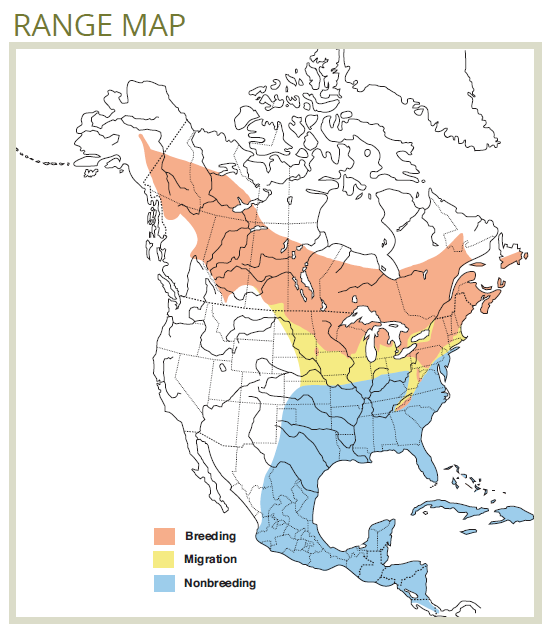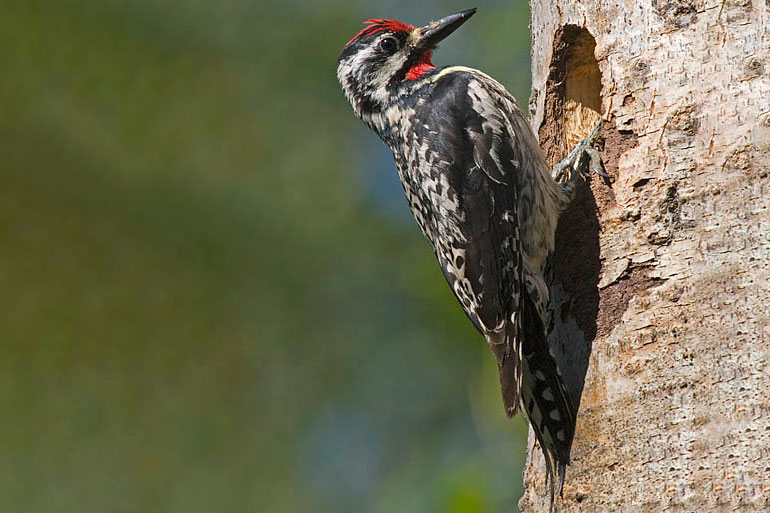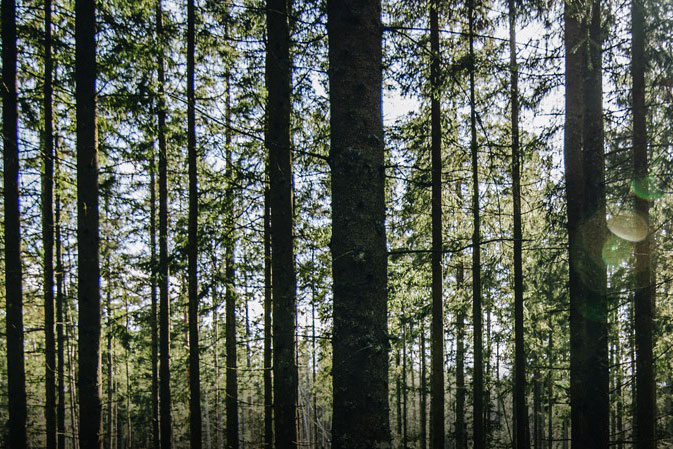Yellow-bellied Sapsucker
(Sphyrapicus varius)
Habitat Ecology
- The Yellow-belled Sapsucker is considered a keystone excavator of forest habitats since a large number of bird and mammal species reuse its old cavities, and many other feed on the sapwells they drill on deciduous trees (including the Rufous Hummingbird).1
- Typical nesting and foraging habitat for this species includes trembling aspen and paper birch, including mixed conifer-deciduous forests.1 It is found in a wide range of forest age classes including early-seral forests that contain large, old trees suitable for nesting.2
- Their preferred nest trees are similar to those of Northern Flickers and Pileated Woodpeckers: large-diameter live deciduous trees with heart rot (mainly aspen >35 cm dbh with 10–25 false tinder conks). Their nests are typically found in clumps of 25–30 trees >12 cm dbh.3

- Foraging habitat includes birch, willow, white spruce and aspen.3 Birch poles are preferred where available and alder is used where there are low birch densities.4
- Nest trees may be reused for 6–7 years, and some reuse of old cavity nests has been observed.1
- In northern BC, Yellow-bellied Sapsuckers were observed almost entirely in upland aspen/poplar/white spruce mixedwood and pure deciduous forests older than 60 years (predominantly in forests older than 90 years). This preference for older stands was attributed to higher densities of nest trees and white birch poles.4
Response to Forest Management
- Yellow-bellied Sapsuckers are resilient to harvests leaving residual structure and/or adjacent unharvested remnants in which they can nest, but they decrease substantially in clearcuts.2,5,6
- This species was not, however, likely to occur in regenerating clearcuts up to 33 years postharvest, suggesting potential long-term negative impacts of extensive harvest without residual structure.7
- Large, aggregated harvests will support more sapsuckers than recently-burned forests,8 but fewer sapsuckers than mature and old aspen and mixedwood stands.3
- Retention harvests may make nesting sapsuckers more vulnerable to predation by black bears if optimal nest trees (see Habitat Ecology) are selectively removed, leaving sapsuckers to nest in less protected trees (e.g., trees left unharvested due to substantial decay). Note: this study was conducted in American Beech forests in Ontario9. Local research is recommended, however unsuccessful black bear nest predation attempts have been observed in Alberta.10
Stand-level Recommendations
- Large aggregated harvests containing retention patches >5 ha, with many patches >15 ha and some patches >100 ha, are recommended as better alternatives to two-pass clearcutting. Larger patches containing both merchantable and non-merchantable trees are desired, and smaller patches should contain mature or old aspen/mixedwood. Smaller patches that provide foraging habitat are also recommended (see below).3,6
- Smaller patches containing foraging features (see below) may also improve habitat value provided they are <60 m from unharvested areas larger than 5 ha (e.g., riparian buffers, remnants) that contain high densities of known or potential nest trees.3,6
- Retention patch anchor points to provide nesting habitat include clumps of potential or known nest trees (see Habitat Ecology) surrounded by clumps of trees >12 cm dbh.3 If possible, >15 living cavity trees per hectare (on average) are recommended to ensure the highest-quality trees can be selected.9
- Retention patch anchor points to provide foraging habitat include clumps of pole stage or younger white birch, provided there are nearby patches or unharvested forest containing suitable nesting habitat. Where white birch is absent, alder, willow, and aspen saplings should be retained.3,10
- Careful communication between harvest and reforestation operators is encouraged to ensure that retained clumps of young trees and shrubs are not damaged during mechanical site preparation.10
- In harvest areas optimized for Yellow-bellied Sapsucker, post-harvest silviculture that reduces white birch and alder densities should be avoided if possible.4
Landscape-level Recommendations
- While this species is resilient to retention harvesting, their conservation on heavily-managed landscapes over the long-term will likely require strategic conservation of stands exceeding the rotation age,11 particularly in northern forests (e.g., northeastern BC) where sapsuckers were rarely observed in stands younger than the rotation age.4
- A variety of retention levels is recommended within the planning unit (e.g., according to the area’s NRV). Of these, stands with ≥20% retention as planned operator patches (mature and old aspen or mixedwood), and up to 50% retention in some blocks, are expected to contribute the most to Yellow-bellied Sapsucker habitat on the landscape (second to unharvested forest remnants).3
References
- Walters, E. L., Miller, E. H. & Lowther, P. E. 2002. Yellow-bellied Sapsucker (Sphyrapicus varius), version 2.0. in The Birds of North America (Rodewald, P. G., ed.) Cornell Lab of Ornithology, Ithaca, New York, USA. Available online: https://doi.org/10.2173/bna.662
- Schieck, J. & Song, S. J. 2006. Changes in bird communities throughout succession following fire and harvest in boreal forests of western North America: literature review and meta-analyses. Canadian Journal of Forest Research 36: 1299–1318. Available online: https://doi.org/10.1139/x06-017
- Cooke, H. A., Hannon, S. J. & Song, S. J. 2010. Conserving Old Forest Cavity Users in Aggregated Harvests with Structural Retention. Sustainable Forest Management Network, Edmonton, AB. 36 pp. Available online: https://doi.org/10.7939/R3JQ0SW3P
- Savignac, C. & Machtans, C. S. 2006. Habitat requirements of the Yellow-bellied Sapsucker, Sphyrapicus varius, in boreal mixedwood forests of northwestern Canada. Canadian Journal of Zoology 84: 1230–1239. Available online: http://www.nrcresearchpress.com/doi/full/10.1139/z06-112#.WlVB-KinFzA
- Norton, M. R. & Hannon, S. J. 1997. Songbird response to partial-cut logging in the boreal mixedwood forest of Alberta. Canadian Journal of Forest Research 27: 44–53. Available online: http://www.nrcresearchpress.com/doi/abs/10.1139/x96-149
- Machtans, C. S., Villard, M.-A. & Hannon, S. J. 1996. Use of riparian buffer strips as movement corridors by forest birds. Conservation Biology 10: 1366–1379.
- Leston, L., Bayne, E. & Schmiegelow, F. 2018. Long-term changes in boreal forest occupancy within regenerating harvest units. Forest Ecology and Management 421: 40–53. Available online: https://doi.org/10.1016/j.foreco.2018.02.029
- Van Wilgenburg, S. L. & Hobson, K. A. 2008. Landscape-scale disturbance and boreal forest birds: Can large single-pass harvest approximate fires? Forest Ecology and Management 256: 136–146. Available online: https://doi.org/10.1016/j.foreco.2008.04.017
- Tozer, D. C., Burke, D. M., Nol, E. & Elliott, K. A. 2012. Managing ecological traps: Logging and sapsucker nest predation by bears. Journal of Wildlife Management 76: 887–898. Available online: http://onlinelibrary.wiley.com/doi/10.1002/jwmg.336/full
- Bonar, R. 2018. Personal communication. April 6, 2018
- Cooke, H. A. & Hannon, S. J. 2012. Nest-site selection by old boreal forest cavity excavators as a basis for structural retention guidelines in spatially-aggregated harvests. Forest Ecology and Management 269: 37–51. Available online: http://dx.doi.org/10.1016/j.foreco.2011.12.042








